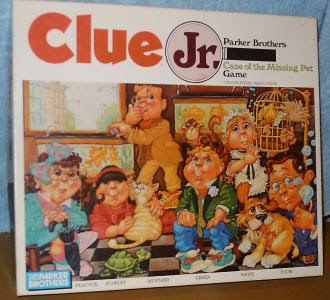Oh man, I thought the post scheduler would work and never checked to see if this post posted. Well, here it is at any rate! This is a post that should have posted about a month ago. As for my current progress on the game, I have decided to change the very broad generic category of 'Animals' to just 'Bugs.' Making it a game of Plant people and Bug people. I thought this would be more apt, as the relationship between bug and plants harbor both supportive and destructive aspects. I shall cover more on that once I have new concept art of Bug people up.
I scoped about online and finally identified the board game that I got the colored filters idea from. The game is Clue Jr.: The Case of the Missing Pet. The original rulesheet for the board game can be found online. I apparently did not play the game correctly when I was little. Have a link: www.hasbro.com/common/instruct/cluejr-pet.pdf
The game is basically an identification game, where randomly drawn variables at the start of the game match the configuration for the location, item of theft and robber that make up the mystery. There is also a forced element of competition. Players must not share their discoveries with one another and rather attempt to try and be the first one to figure out the three components of the mystery first.
The filters, in this case then, act as something that divides all the individuals and holds an element of selfishness. When a player lands on a board square that grants them use of their magnifying lens (the red colored filter), they then proceed to use it on a clue space without letting anyone else peek.
 |
| Here you can see the lens in action. It removes the mottling, allowing its single owner to peek at a clue. |
In my appropriation of this mechanic the mottled design becomes indicative instead of the blind spots that a culture may have when reflecting upon themselves, on the importance of others who can see through different lens to have a more complete picture of themselves. The lens of others with another perspective can shed light to aspects they would not have identified otherwise. They are a source of clarity; the lens becomes not a selfish means of accumulating a currency of knowledge, but rather a means of empowering the other team in an act of altruism. The lens becomes a more pivotal part of the game because of the way they connect the two teams; without the crossing of lens the game cannot be won.
Going back to Clue Jr., a very simple change that would make better use of the lens and remove what I feel to be an unnecessary competitive element would be to place all players on a single team, then utilize some kind of countdown that represents the suspect. There would be a limited number of turns that the players could take before the culprit in essence 'escapes' successfully. The players could work together to figure out the culprit within the allotted number of turns, strategically combining the information they glean together. There is also an opportunity for a challenge: players could try and see the minimal number of turns they need to take to solve the mystery. The game becomes redirected towards busting the guilty member, rather than on one-upping one another.
At the moment I am looking at different filters and on ways to recreate the clever mottled pattern mechanic the game implements. I have a blue filter that works very well in removing traces of cyan. I'm still having trouble finding a red filter. At the end of the post you can see two: one does not remove red at all: the other not only removes red, but obfuscates all colors altogether. I also have different colors such as yellow and green, so I may experiment with that as well.
Clue Jr. also has its filters applied to real magnifying lens, so that the clues can be further hidden within the mottled pattern. I will probably apply a cheap magnifying lens I've bought at the dollar store to the filters that work best with mottling.
3D anaglyph images have been helpful in testing filters, and further research into anaglyph images (the red-blue 3D images we're familiar with) should help me figure out what filters work best for colors in addition to the standard red and blue.
 |
| Various lenses I am trying out. |
 |
| A 3D anaglyph image for testing |
 |
| The blue lens works great! All you can see are strips are red amongst a black-and-white image. |
 |
| The blue lens's red counterpart unfortunately don't work as well. Red is not masked properly. |
 |
| The red PVC filter I have works too well, blocking out ALL colors quite effectively. |

